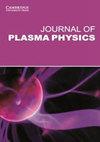Development of a field-reversed configuration device using radio frequency antennas to produce E × B for current-drive
IF 2.1
3区 物理与天体物理
Q2 PHYSICS, FLUIDS & PLASMAS
引用次数: 0
Abstract
A unique field-reversed configuration (FRC) experiment is presently being assembled at the Plasma Technology Research Institute, KFE. It is a compact small-scale FRC device, which uses a set of radio frequency (RF) antennas to produce an internal E × B that drives the electrons for current-drive, in which E is the electric field and B is the magnetic field. This is very similar to the rotating magnetic field (RMF) current-drive, where the horizontal and vertical antennas are driven 90° out of phase. For this device, the RF antennas are arranged differently than the RMF. The RF antennas, being two separate sets, are positioned inside the vacuum chamber. Each set consists of 8 coils, for a total of 16 coils, where 80~100 kHz sine and cosine waveform currents are applied. One set of coils generates a radial B-field, while the other set provides an E-field in the z-direction. As the phase changes, the E and B fields are switched by these two sets. Nevertheless, E × B propagates in the same θ-direction so that this allows the electrons to rotate around the circumference of the device. The FRC device will test wave heating by launching 2.45 GHz microwaves. Also, passive stabilizers are positioned at each end to provide extra stability while preventing tilt instability. The experiment is expected to produce its first plasma in 2025.利用射频天线开发场逆配置装置,为电流驱动产生 E × B
目前,KFE 等离子体技术研究所正在组装一个独特的场反转配置(FRC)实验。这是一个紧凑的小型 FRC 设备,它使用一组射频(RF)天线产生内部 E × B,驱动电子进行电流驱动,其中 E 是电场,B 是磁场。这与旋转磁场(RMF)电流驱动非常相似,其中水平和垂直天线的驱动相位相差 90°。对于这种装置,射频天线的布置方式与 RMF 不同。射频天线分为两组,分别放置在真空室内。每组由 8 个线圈组成,共 16 个线圈,施加 80~100 kHz 正弦和余弦波形电流。一组线圈产生径向 B 场,另一组提供 Z 方向的 E 场。随着相位的变化,E 场和 B 场由这两组线圈切换。尽管如此,E × B 仍沿相同的 θ 方向传播,从而使电子能够围绕装置的圆周旋转。FRC 设备将通过发射 2.45 GHz 微波来测试波加热。此外,两端还安装了被动稳定器,以提供额外的稳定性,同时防止倾斜不稳定性。该实验预计将于 2025 年产生第一个等离子体。
本文章由计算机程序翻译,如有差异,请以英文原文为准。
求助全文
约1分钟内获得全文
求助全文
来源期刊

Journal of Plasma Physics
物理-物理:流体与等离子体
CiteScore
3.50
自引率
16.00%
发文量
106
审稿时长
6-12 weeks
期刊介绍:
JPP aspires to be the intellectual home of those who think of plasma physics as a fundamental discipline. The journal focuses on publishing research on laboratory plasmas (including magnetically confined and inertial fusion plasmas), space physics and plasma astrophysics that takes advantage of the rapid ongoing progress in instrumentation and computing to advance fundamental understanding of multiscale plasma physics. The Journal welcomes submissions of analytical, numerical, observational and experimental work: both original research and tutorial- or review-style papers, as well as proposals for its Lecture Notes series.
文献相关原料
| 公司名称 | 产品信息 | 采购帮参考价格 |
|---|
 求助内容:
求助内容: 应助结果提醒方式:
应助结果提醒方式:


